Sign up to our mailing list for the best stories delivered to your inbox.
Jane Smith shares some of her favourite smoko recipes, including a light fruit cake, berry scrolls, banana and chocolate muffins, and hedgehog slice.
WORDS AND PHOTOGRAPHY JANE SMITH
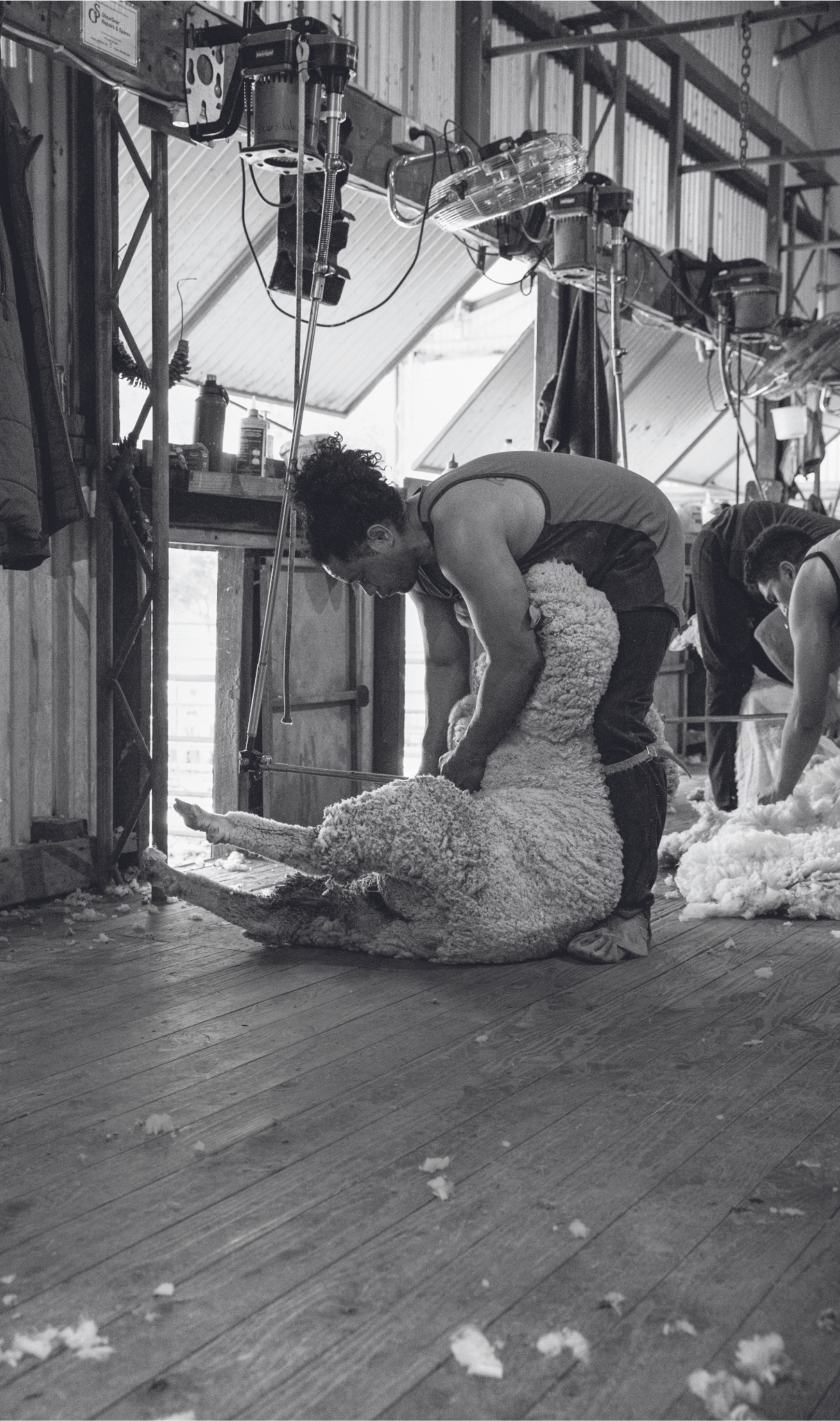

The bedrooms were in a long building that was also made of corrugated iron, with a generous verandah and a big, echoey room, known as the recreation room, at one end. Those basic but proud buildings stood silent for most of the year, while a thin layer of red dust settled on every surface and the occasional mouse took up residence.
As shearing time approached it would be all female hands on deck to wash the mattress covers, sweep the floors, wipe down benches and prepare for the arrival of the contract shearing team. Then suddenly there would be a flurry of cars, people and dogs as the shearers arrived and turned the quarters into their temporary home.
When we were children, the woolshed was an exciting, busy and noisy place to be. The wool was inspected as it was sorted; there were many serious discussions with the wool classer. Dogs barked, fleeces flew through the air and smoko arrived like clockwork at 9.30am and 3pm every day.
Merino sheep are hardy animals. They live their days in distant paddocks with minimal intervention. They walk in to the troughs for a drink every day and walk out again to forage for feed. As land dries off, they have to walk further to find enough grass to sustain them. The ewes have their lambs: all going to plan, the lambs are on their wobbly feet within hours, following their mothers and guzzling a feed when they can.
Year after year the mobs march into the yards for shearing, crutching and lamb marking. Then they return to their paddocks in one continuous woolgrowing cycle.
That same old woolshed from my childhood is silent these days. As with many properties in western New South Wales, merino sheep have been phased out due to significant labour costs in an industry where workers are becoming harder to find. Businesses are shifting to the dorper breed, or similar, for their ability to gain weight rapidly, their high fertility and their ability to shed their own fibre, so shearing is not required.
I think about all the woolsheds that are now sitting idle on properties around the bush as farming families diversify and the labour force changes. The oily boards, still thick with lanolin from the thousands of fleeces that have pressed against them over the years. The dusty smoko tables and dry teapots, the empty wool storage areas, the quiet pens with no sheep or dogs rushing through them. The creaky louvre windows slowly cracking and rusting.
I daydream about possible future uses for these old buildings with their textured tin, timber and stonework. Some could be transformed into creative workshop spaces, function centres, accommodation or artists’ studios. Of course, in reality most woolsheds are in isolated areas, they require constant maintenance and the expenses involved are staggering. Nonetheless, I continue to think about it.
Today, part of our family’s farming enterprise is still dedicated to producing wool and breeding merinos. I feel an enormous sense of pride and nostalgia every year when our shearing season arrives. Shearing time means smoko, usually served in the woolshed among the wool and the busyness of the sheep and shearers.
I hope you enjoy these recipes: whether you might be shearing sheep or simply daydreaming about future projects while you have a cup of tea.
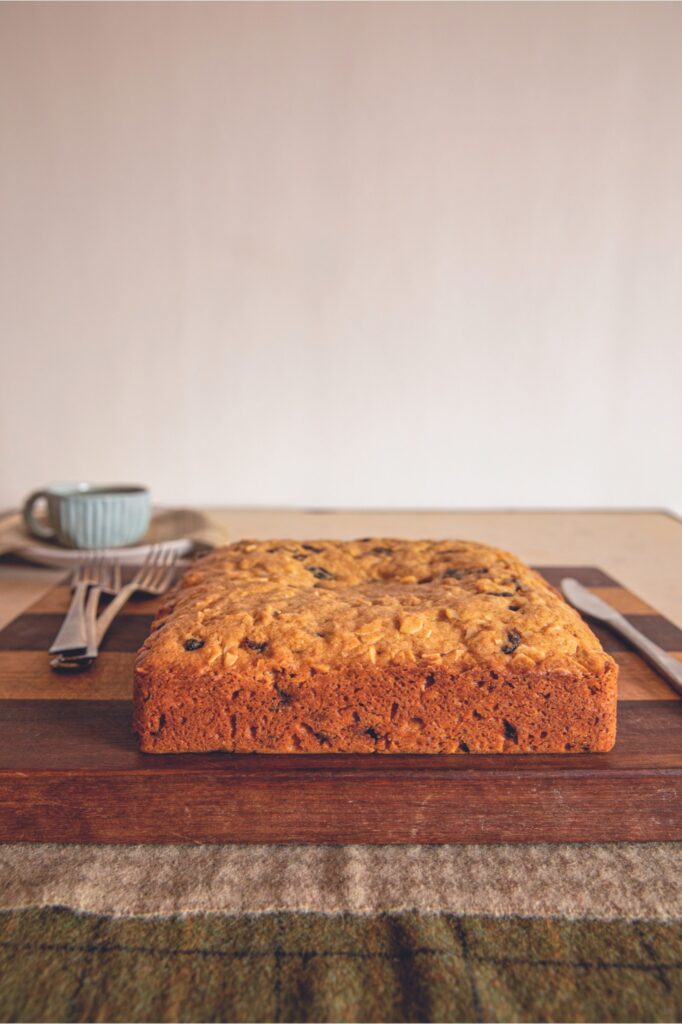
LIGHT FRUIT CAKE
This cake can be stored in an airtight container for up to a week.
Serves 15–20
250g butter, softened
1 cup (220g) caster sugar
1 teaspoon vanilla essence
Zest of 2 lemons
3 eggs
1 teaspoon mixed spice
2 teaspoons baking powder
2½ cups (375g) plain flour
1/3 cup (80ml) liquid, such as orange juice, lemon juice, brandy or sherry
300g mixed dried fruit, such as sultanas, currants and raisins
100g slivered almonds
1. Preheat the oven to 180°C. Line a high-sided 20cm square cake tin with baking paper. Set aside.
2. Put the butter, sugar, vanilla and zest into a mixing bowl. Beat until pale and fluffy.
3. Add the eggs, one at a time, mixing well after each addition.
4. Sift in the mixed spice, baking powder and flour, then add the liquid, fruit and almonds and mix until combined.
5. Spoon the mixture into the tin and smooth using the back of a spoon. Bake for 40-50 minutes or until a skewer inserted into the centre comes out clean.
6. Remove from the oven and cool for 20 minutes in the tin. Remove from the tin and place on a wire rack to cool.
BERRY SCROLLS
Starting this recipe the day before gives you the advantage of being able to take the scrolls out of the fridge in the morning and having them ready in time for morning smoko.
Makes 8 scrolls
1 cup (250ml) milk, warmed slightly
150g butter, melted
¼ cup (55g) caster sugar, plus 1 tablespoon extra, for topping
7g sachet instant dried yeast
1 egg, lightly beaten
1 teaspoon salt
4 cups (600g) plain flour
200g fresh berries, such as blueberries, raspberries or a mixture
Glaze
50g caster sugar
100ml milk
1. Line a 20cm square baking dish or cake tin with baking paper. Set aside.
2. Put the warm milk, melted butter and sugar in a bowl and stir to combine. Stir in the yeast and set aside for 5 minutes or until the yeast is bubbling.
3. Put the egg, salt and flour into a large mixing bowl. Add the yeast mixture and combine into a rough dough.
4. Turn out the dough onto a clean work surface and knead it with your hands for about 5 minutes until the dough forms a smooth ball.
5. Transfer the dough to a lightly greased bowl, cover and set aside in a warm place for about 3 hours to rise.
6. On a clean work surface, roll out the dough to a 60cm x 40cm rectangle and 1cm thick. Trim the edges so they are straight and cut the dough lengthways into 5cm-wide strips. Place a line of berries along the centre of each strip — there is no need to completely cover the dough in berries. Roll up each strip into a spiral, enclosing the berries as you roll. (You may need to push the berries back into place as you roll it up.)
7. As you finish rolling each spiral, place it in the baking dish. The spirals should be touching each other but not too tightly packed. Cover and refrigerate overnight.
8. The next day, remove the scrolls from the refrigerator and set aside in a warm place for 2 hours.
9. Meanwhile, preheat the oven to 200°C. Sprinkle the extra sugar over the scrolls in the tin and bake for 25–30 minutes until golden in colour and cooked through.
10. Meanwhile, to make the glaze, combine the sugar and milk in a small saucepan over low heat and stir until the sugar has dissolved. Use a pastry brush to apply the glaze to the cooked scrolls while they are still warm.
11. Pull scrolls apart and serve warm.


JAM DROPS
My paternal grandmother made these as simple biscuits that she would top with a glacé cherry. They are very soft and buttery and always remind me of my childhood.
Makes about 20 biscuits
1/3 cup (75g) caster sugar
155g butter, softened to room temperature
1½ cups (225g) plain flour
¼ cup (80g) jam, any flavour
1. Line two baking trays with baking paper and set aside.
2. Put the sugar and butter in a mixing bowl and beat by hand or with electric beaters until pale and fluffy.
3. Sift in the flour and beat to combine.
4. Roll tablespoons of the mixture into balls. If the mixture seems too dry, bring it together gently with clean hands. The warmth from your hands will be enough to make it manageable. Place the balls on the baking trays approximately 5cm apart to allow for spreading.
5. Flatten the balls slightly and make a small indent with your thumb in the top of each biscuit. Fill the indents with jam. Transfer the trays of biscuits to the refrigerator for 30 minutes.
6. Meanwhile, preheat the oven to 160°C.
7. Transfer the chilled biscuits to the oven and bake for 30 minutes or until very pale golden in colour.
8. Allow to cool completely on a wire rack.
BANANA & CHOCOLATE MUFFINS
Best served on the day of baking. These muffins are perfect for using up overripe bananas, and they are firm enough to pack into lunchboxes.
Makes 12
1/2 cup (125ml) neutral-tasting oil, such as grapeseed oil
1 cup (220g) caster sugar
3 ripe bananas (about 300g),mashed
2 eggs, lightly beaten
1 teaspoon vanilla essence
175g dark chocolate chips
2 cups (300g) plain flour
2 teaspoons baking powder
1. Preheat the oven to 180°C. Line a 12-hole muffin tin with paper muffin cases. Set aside.
2. Put the oil, sugar, banana, egg, vanilla and chocolate chips in a large mixing bowl. Stir to combine.
3. Sift in the flour and baking powder and stir gently to combine. Do not overmix.
4. Divide the mixture between muffin cases and bake for 25-30 minutes until a skewer inserted into the centre of a muffin comes out clean.
5. Allow to cool for 5 minutes in the tin, then transfer muffins to a wire rack to cool completely.
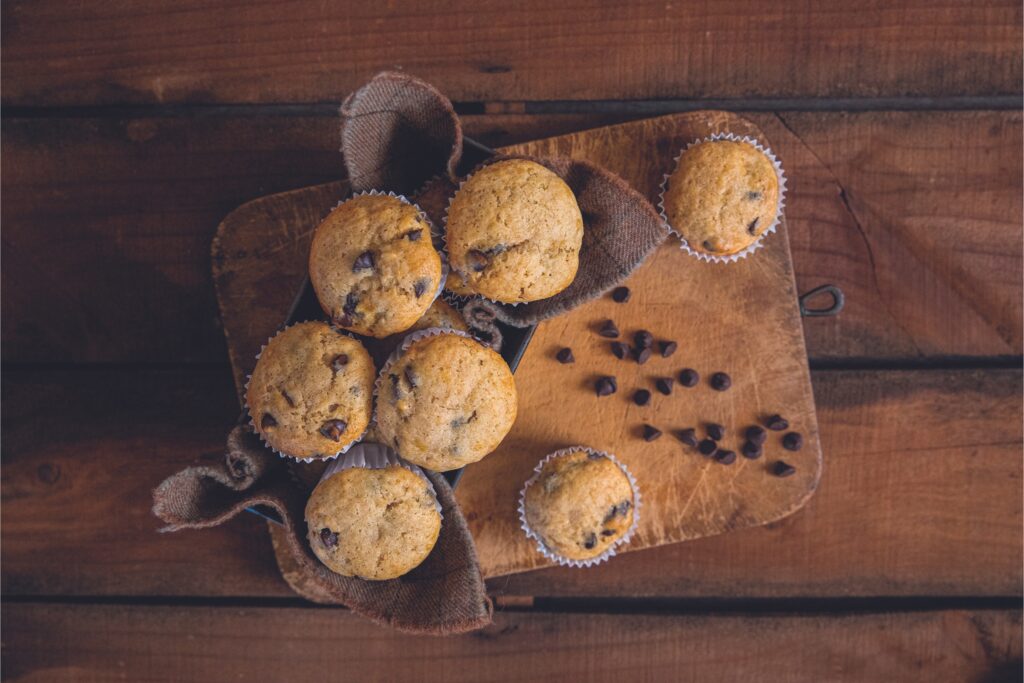
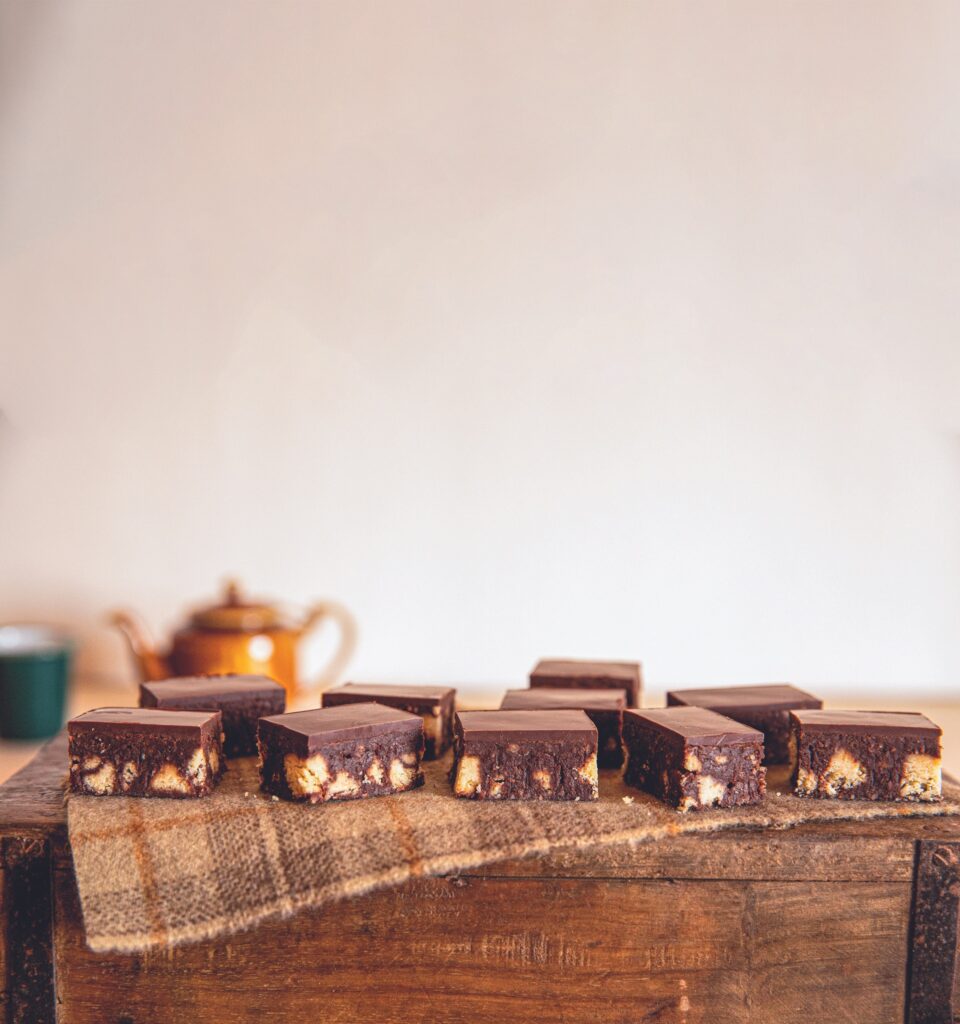
HEDGEHOG SLICE
This is a slice I make before school holidays, to prepare for having hungry teenagers at home.
Makes 30 pieces
150g dark cooking chocolate, chopped
100g butter, chopped
295g condensed milk
250g shortbread biscuits, broken into small chunks
½ cup (40g) desiccated coconut
2 tablespoons cocoa powder
Topping
180g dark cooking chocolate, chopped
1 tablespoon vegetable oil
1. Line an 18cm x 28cm slice tin with baking paper and set aside.
2. Stir the chocolate, butter and condensed milk in a small saucepan over low heat for about 3 minutes until the mixture is melted and smooth. Set aside to cool slightly.
3. Put the broken biscuits into a mixing bowl and add the coconut and cocoa. Stir to combine.
4. Pour the melted chocolate mixture into the bowl with the dry ingredients and mix until combined.
5. Press the mixture evenly into the slice tin and refrigerate until just firm.
6. For the topping, stir the chocolate and oil in a small saucepan over low heat until the chocolate has melted and is combined with the oil.
7. Pour the topping evenly over the slice. Carefully tilt the tin from side to side to spread the topping evenly. Refrigerate until set. Cut into 3cm x 6cm bars to serve.
Visit The Shady Baker website or find Jane on Instagram.
Subscribe to Graziher and never miss an issue of your favourite magazine! Already a subscriber? You can gift a subscription to someone special in your life.
To hear more extraordinary stories about women living in rural and regional Australia, listen to our podcast Life on the Land on Apple Podcasts, Spotify and all major podcast platforms.
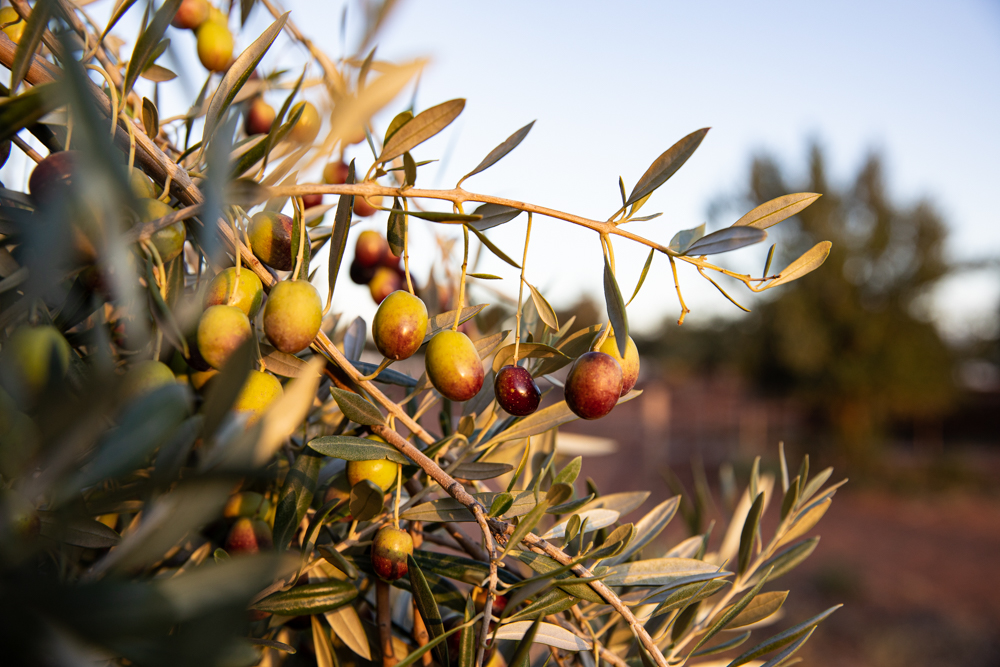
The Shady Baker celebrates this year’s bountiful olive harvest with recipes highlighting both the oil and the fruit.

After losing her husband, Penny Button took the reins at Crossmoor, managing the vast property near Longreach, Queensland.

Sending her boys to boarding school was a tough decision, but Dannielle Lees wants them to experience the best of life in Sydney.